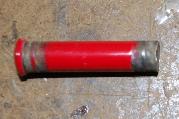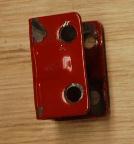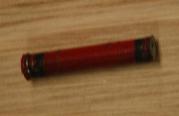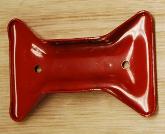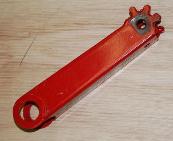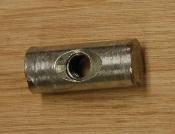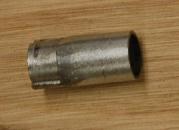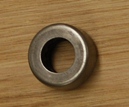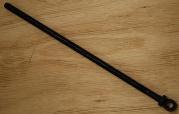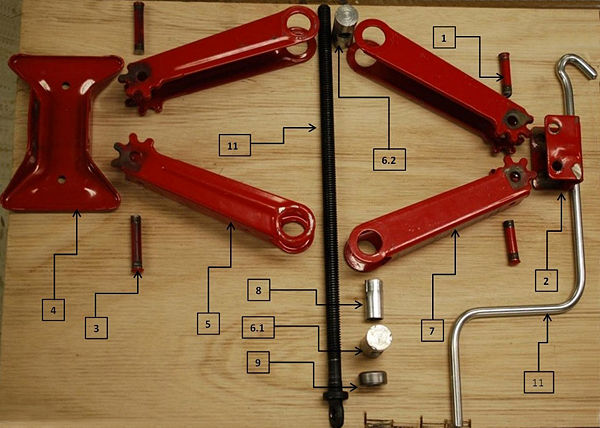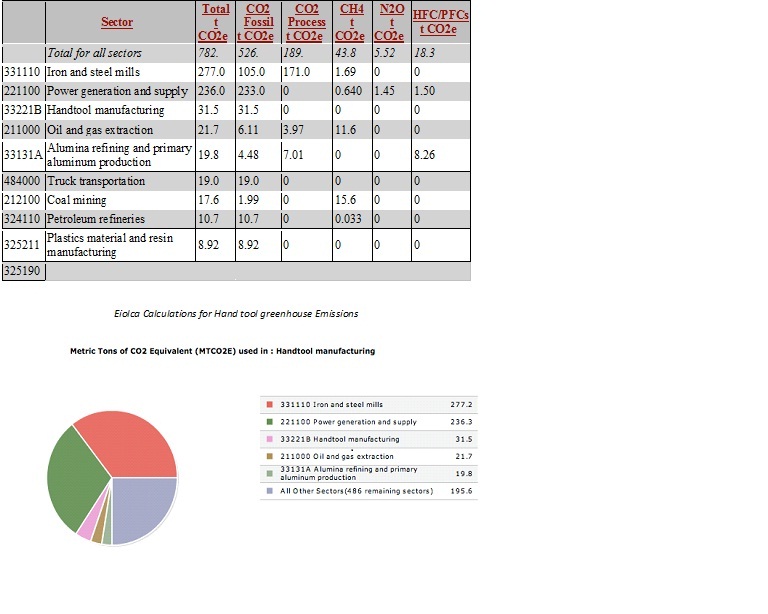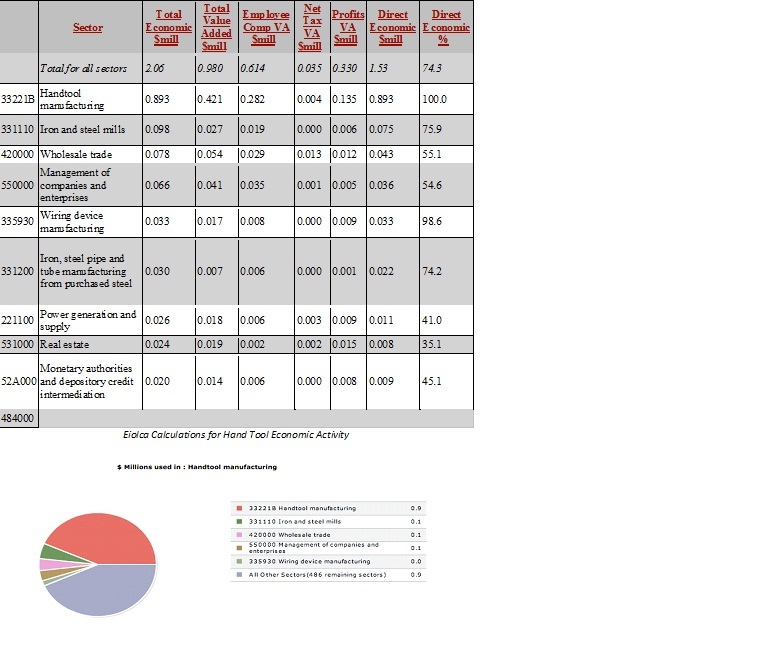Tire changing kit
From DDL Wiki
Contents |
Executive Summary
Place Executive Summary
Stakeholders and Associated Needs
The primary post-production stakeholders include the users, retailers, freight carriers, and businesses.
User
- Vehicle Owner
- Inexpensive
- Easy to use
- Light weight
- Reliable
- Adaptable to multiple surfaces
- Easily assembled
- Easily stored
- Mechanics / Roadside Servicemen
- Easy to clean
- Replaceable parts
- Light weight
- Able to be used on a variety of surfaces
- Reliable
Retailer
- Compact
- Inexpensive
- Easily manufacturable parts
- modular
Transporter
- Compact
- Lightweight
- sturdy
Businesses
- Compact
- Lightweight
- Inexpensive
- reliable
Usage Study
- Step 1 – Jack is raised from full lowered position to a suitable starting height and placed under vehicle.
- Step 2 – Vehicle Raised and supported by jack by turning drive screw
- Step 3 – Tire Removal and Installation (Note: this part is a manual process)
- Step 4 – Jack lowered and removed
- Step 5- Jack completely lowered in the storing position and handle removed.
Assembly Component and Mechanical Function
Ac and MF
Exploded View and Bill of Materials
Main Components
As can be seen in the table below, the standard Car-Jack contains 11 unique parts and 16 total parts(including screws and pins), all of which are made out of steel of cast steel. Most of the parts have been designed to maximize strength while decreasing weight and cost. We were able to completely disassemble the mechanism to its component level, since the entire mechanism was manufactured using a single layer of assembly.
Assembly: Exploded View
Preliminary DFMA
Product dissection revealed that the manufacturer took both manufacture and assembly into consideration when designing the product. It is clear that the manufacturer attempted to minimize production cost and assembly time. A summary of the design considerations and areas of improvement is included below. (Observations are marked as obs, recommendations are marked as rec)
Design for Maufacture (DFM)
- Minimize Part Count
- obs- The Product already uses the minimum number of parts to complete the task.
- Standardize Components
- rec- Use off the shelf locknut instead of aluminum collar on drive screw
- Commonize Product Line
- obs- The “Big Red” line of scissor jacks comes in multiple load ratings. As such each model has to be sized for the desired load. Despite this need for different strength parts, the similarity allows personnel to be trained on one unified design.
- Standardize Design Features
- obs- The design of the jack is symmetric. As a result many of the parts come in pair simplifying manufacture
- rec- Instead of different width upper and lower arms, use the same width and interleave the assembly (might cause stability issues)
- Keep Designs Simple
- obs- In accordance with the minimum number of components, the design does not include any frivolous features that would complicate the design.
- Multifunctional Parts
- obs- The design as is does not include any multifunctional parts.
- rec- Possible area for improvement. A good example would be to use the jack handle as a lug wrench.
- Ease of Fabrication
- obs- The majority of parts are stamped steel components. This is a cost effective method for high volume production
- Avoid Tight Tolerances
- obs- None of the components are high tolerance
- obs- Rivets expand to fit holes when compressed
- Minimize Secondary and Finishing Operations
- obs- Due to the steel construction most components are painted to avoid rusting
- Take Advantage of Special Process Properties
- obs- No Special Processes are used in construction
- Other
- obs- Arm length selected to achieve desired max lift height
- obs- Bottom and Top plate sized for stability
Design for Assembly (DFA)
- Minimize Part Count
- obs- The Product already uses the minimum number of parts to complete the task.
- Minimize Assembly Surface
- obs- All assembly surfaces are sliding surfaces. As a result there is already a minimum assembly surface
- Use Subassemblies
- obs- Design includes only one assembly
- Mistake-Proof
- obs- Fastener and components are sized to only fit together in one arrangement
- Minimize Fasteners
- obs- The design uses only the number of fasteners require to provided necessary motion
- Minimize Handling
- obs- Assembly is likely put together in one step using an assembly jig.
- Minimize Assembly Directions
- obs- Assembly is already simplified
- Provide Unobstructed Access
- rec- Replace Rivets with shoulder bolts and lock nuts for serviceability (This might have been deliberately avoided by manufacturer)
- Maximize Assembly Compliance
- rec- Chamfer Teeth for easy assembly
Preliminary FMEA
| Item and Function | Failure Mode | Effects of Failure | Severity | Causes of Failure | Occurance | Design Controls | Detectibility | Risk Priority | Recommended Actions |
|---|---|---|---|---|---|---|---|---|---|
| bearing | binding | unable to crank | 5 | dirt, water freezing | 2 | sealing / protecting bearing from environment, or enabling maintenance | |||
| overloading | deformation of frame, failure of threads on dry rod due to abrasive wear | inoperable due to deformation or threads ruined | 9 | external leverage enabling lifting overweight. Overloading after raised | 3 | valve caps. If overload - visual indicator. Load gauge. Or limit useability in high load conditions with thread pitch | |||
| piercing tire with rod | damage tire | 3 | 2 | ||||||
| base not level | object falls off or jack collapses | danger to user - jack deformation | 4 | car tilted - jack collapses. | 6 | ||||
| incorrect placement | danger to car - jack deformation | 4 | Car on slope - car falls off / possible deformation |
Design For Environment (DFE)
Design for Environment (DFE) is an analysis of how a CO2 tax would impact the cost of production or use of the scissor jack. In our analysis we will take into consideration the entire life cycle of the jack, aka a life cycle analysis (LCA). We will consider the material extraction, production, use, end of life, and transportation of the product. As a painted steel tool, our material extraction would entail coal mining, iron ore mining, and paint manufacturing. For production, the material would then have to be smelted into steel sheets and then crafted into the scissor jack. For this entire process we have chosen the hand tool sector on eiolca.net. We chose this sector because it analyzes non-powered hand and edge tools – a description that best matched our product. We also looked at the Detailed Item Output from the 2002 Benchmark Input-Output Accounts on bea.gov in order to confirm that the hand tool sector includes tools similar to that of a scissor jack. Since there are items such as “mechanic’s service tools” as well as other tools made out of steel, we can conclude that the hand tool sector is an accurate description of our product.
Production
Greenhouse Gasses
In 2002, for every one million dollars spent in retail value on scissor jacks, 782 metric tons of Carbon Dioxide are emitted into the atmosphere. Scaling this down to units of metrics tons per jack, we see that the creation of one jack emits approximately 0.023 metric tons of Carbon Dioxide. The emission emitted from iron and steel mills and power generation supply contribute the vast majority of the Carbon Dioxide release (66%). If a Carbon Dioxide tax of $30 per metric ton of CO2 is enacted, a total of $23, 450 would be taxed per million dollars sold. This equates to 70 cents per scissor jack, or approximately 2%. This cost is noticeable, but would have a small implication on the cost of the product.
Economic Activity
In 2002, for every one million dollars spent in retail value on scissor jacks, 2.06 million must be spent during the complete economic supply chain. We can also note that 74.3% of the economic cost goes directly towards the manufacturing of the product.
Use
Our product does not require assembly, power, or additional lubrication to use. It is ready-to-go when taken out of the box. Because of its simplicity, the only emissions generated from its use would be the effect of driving with the additional weight of the product in the car. Our product weighs approximately 6.9 lbs. Using the data available on “fueleconomy.gov,” an additional 100 lbs in a vehicle can reduce the gas mileage by a maximum of 2%. 7 lbs equates to approximately 0.14% max reduction in gas mileage. Using the information on http://www.epa.gov/oms/consumer/f00013.htm, we find that the average pollution per person is approximately 11,500 pounds of Carbon Dioxide per year. Assuming that gas mileage has a direct effect on the emission of Carbon Dioxide, we calculate that the extra weight of a scissor jack causes an emission of 16.1 pounds of Carbon Dioxide per year. Compared with the 0.023 metric tons (50.7 lbs) of carbon dioxide generated for the creation of this product, the added weight of once scissor jack makes a noticeable difference.
If we assume that an individual maintains the amount of driving approximately above for 50 years and that a scissor jack will work properly for the 50 years, we see that an extra scissor jack will cause an extra 805 lbs of Carbon Dioxide to be emitted over the course of the driver’s lifetime. This Equates to .365 metric tons per jack and with a $30 CO2 tax, an individual will pay an extra $10.95 in Carbon Dioxide emissions. This price is negligible compared to the cost of gas for the car over 50 years.
End of Life
The jack is made entirely of steel and can be melted down and re-used.
Conclusions
We have concluded that a Carbon Dioxide tax would have a small impact on the life cycle of the scissor jack. The scissor jack is already compact, and has the minimum number parts necessary to function correctly. The only areas where we can reduce the amount of emissions from Production of the jack are to either: 1) make the jack handle into a lug wrench so that we can minimize parts; or 2) make a smaller version of the jack that can only be used for compact cars. Both of these options would reduce the material amount. The first option has no downside, but with the second option – we would have to be careful that consumer did not misread the box and attempt to use the smaller jack on a vehicle that is too heavy to support.
References
www.fueleconomy.gov http://www.epa.gov/oms/consumer/f00013.htm, http://www.eiolca.net
Team Member Roles
Roles
